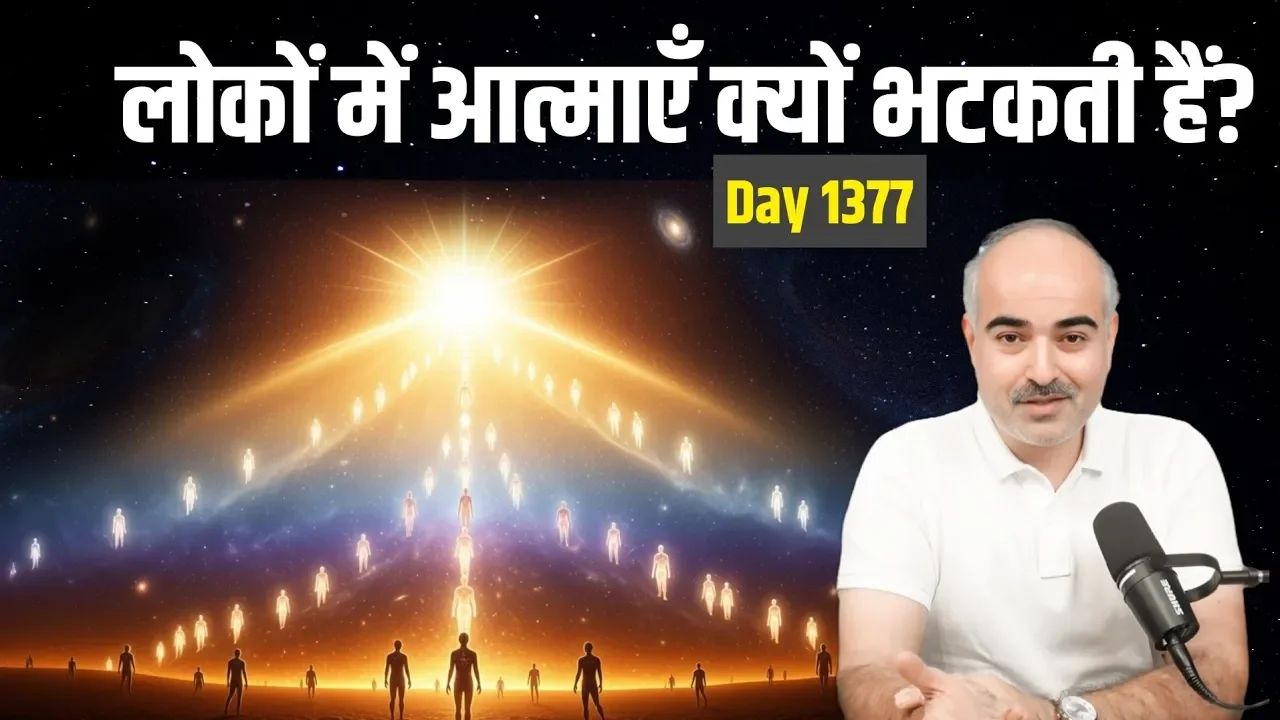Why Do Souls Wander Across Different Realms?
Souls wander across realms due to karma, ignorance, and attachment. The Vedas, Upanishads, and Bapuji’s Behad Gyan reveal that the soul’s vibration decides its destination — higher worlds of light for the pure and lower realms of darkness for the impure. Liberation comes only through self-realization and connecting with Param Shanti, the infinite peace of the Supreme.
Introduction
The journey of the soul after leaving the physical body has been one of the most mysterious subjects in spiritual philosophy. The Vedas, Upanishads, and Puranas describe the various realms (lokas) where souls travel according to their karma, purity, and spiritual awareness. In this discourse inspired by Bapuji’s divine knowledge, we explore why souls wander across worlds, who ascends to higher realms, and who falls into lower planes of existence.
1. The Two Spiritual Paths: Devayana and Pitriyana
According to the Vedas and Upanishads, souls follow two primary paths after death — Devayana (the northern path) and Pitriyana (the southern path).
Devayana is the path of knowledge and realization. Souls who have attained spiritual wisdom, self-realization, and awareness of their divine nature move upward through the solar path and reach Brahmalok, the abode of ultimate truth and peace.
Pitriyana, on the other hand, is the path of ritual and virtue. Souls who perform good deeds, charity, and worship travel to Chandralok (heavenly realm) where they enjoy the fruits of their karma. However, after their merits are exhausted, they must return to Earth and be reborn.
Thus, only knowledge and realization of one’s soul form led to permanent liberation.
2. The Realms of Existence: Higher and Lower Worlds
The Puranas describe fourteen realms (lokas) — seven higher and seven lower.
Higher realms include Earth (Bhulok), Bhuvarlok, Swargalok, Maharlok, Janalok, Taplok, and Satyalok. Souls residing in these realms vary from ordinary humans to sages, yogis, and divine beings.
Swargalok houses virtuous souls who have done noble deeds.
Maharlok and Janalok are homes to great sages and creators.
Taplok is the realm of those who perform deep penance.
Satyalok (Brahmalok) is where the realized souls — the knower of Brahman — reside.
Lower realms (Atal, Vital, Sutal, Talatal, Mahatal, Rasatal, and Patal) are inhabited by dark, violent, or lustful souls who misuse power and live in ignorance, anger, and material desires. These souls are drawn downward by the heaviness of their vices.
3. The Nature of Souls: Tamasic and Sattvic Vibrations
Bapuji explains that every soul vibrates according to its spiritual quality.
Tamasic souls are full of darkness, laziness, violence, and sensual desire. Their thoughts are heavy, confused, and restless. Because of their negative vibrations, they sink into lower realms or remain trapped on Earth as spirits or restless energies.
Sattvic souls, on the other hand, are light, pure, and divine. Freed from attachments, desires, and anger, their subtle bodies become lighter and naturally rise toward the higher worlds of light. Their nature is peace, devotion, and purity.
As light rises upward and darkness sinks downward, so too do souls ascend or descend according to their spiritual vibration.
4. The Cause of Wandering: Karma, Ignorance, and Attachment
The scriptures say: “By karma beings are born, and by karma they perish.”
Every action — good or bad — binds the soul to the cycle of birth and death.
Good deeds lead to temporary pleasures in higher worlds.
Evil deeds drag the soul to darker regions of suffering.
Ignorance of one’s true divine nature causes endless wandering between these realms.
Bapuji clarifies that until the soul realizes “I am the soul, not the body,” and connects with the supreme realm of infinite peace (Paramdham), it continues moving from one world to another — sometimes as human, sometimes divine, sometimes as a ghostly being.
5. The Way to Liberation: Knowledge and Inner Purity
The solution lies in Brahma Gyan (divine knowledge) and self-realization.
The Upanishads emphasize knowledge and meditation on the inner Self. The Puranas speak of devotion, penance, and good conduct. Bapuji combines these truths and reveals that liberation comes when the soul:
Attains divine knowledge and recognizes its eternal identity.
Purifies the mind of anger, lust, greed, and attachment.
Connects to the vibrations of Param Shanti — the supreme peace of the Infinite Light.
A soul that stabilizes in this awareness becomes free from all cycles of birth, death, and wandering.
Conclusion
Souls wander across different realms because of their karmic bonds, ignorance, and spiritual heaviness. When the mind is impure and filled with desires, it pulls the soul downward. When the mind is pure and peaceful, it lifts the soul upward toward its divine source. Bapuji teaches that the ultimate home of every soul is Paramdham, the realm of eternal peace and light. Through constant remembrance of the Self, selfless service, and spreading vibrations of peace, every soul can one day return to that infinite abode of divine light — the true home of all creation.

